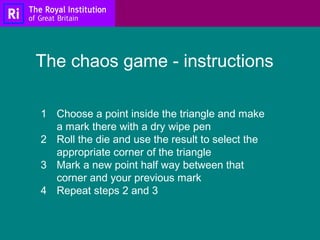How to create a Sierpinski triangle pattern
•Download as PPT, PDF•
0 likes•304 views
Report
Share
Report
Share

More Related Content
What's hot (17)
Viewers also liked
Viewers also liked (7)
Similar to How to create a Sierpinski triangle pattern
Similar to How to create a Sierpinski triangle pattern (20)
Other Sizes - Part 4 of The Mathematics of Professor Alan's Puzzle Square

Other Sizes - Part 4 of The Mathematics of Professor Alan's Puzzle Square
More from grade5b
More from grade5b (9)
How to create a Sierpinski triangle pattern
- 1. 1 Choose a point inside the triangle and make a mark there with a dry wipe pen 2 Roll the die and use the result to select the appropriate corner of the triangle 3 Mark a new point half way between that corner and your previous mark 4 Repeat steps 2 and 3 The chaos game - instructions
- 2. How would you describe the pattern that forms? Why are there no dots in the largest white triangular area? Can you explain this pattern?
- 4. Now make your own Sierpinski triangle. How many triangles do you need to draw in at each stage? What is the pattern? How much of the remaining area are you shading in at each stage?
- 5. The connection with Pascal’s triangle By filling in the number of routes to each block, construct a few more lines of Pascal’s triangle. Now colour in the blocks that contain even numbers. What do you notice? Why do you think this happens? 1 1 11 1 1 1 1 1 1 1 1 1 2 3 4 6 10 20 5 6 3 4 10 5 1515 6 11 3535 2121 77
- 6. The connection with Pascal’s triangle By filling in the number of routes to each block, construct a few more lines of Pascal’s triangle. Now colour in the blocks that contain even numbers. What do you notice? Why do you think this happens? 1 1 11 1 1 1 1 1 1 1 1 1 2 3 4 6 10 20 5 6 3 4 10 5 1515 6 11 3535 2121 77